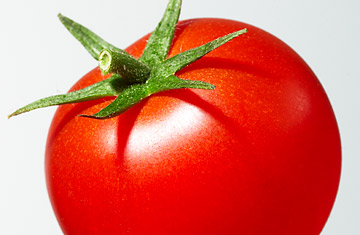
There are two pieces of late-breaking news on the tomato beat this week. First of all, tomatoes have shoulders. Second, tomatoes taste lousy. If you're younger than 70, you probably already know about the lousy part. The shoulders are surely more of a surprise — but these are both key parts of a new study published in Science that explains what's going on in the sorry world of supermarket tomatoes and why they taste nothing like their sweet, flavorful cousins in the wild.
It was a good 70 years ago that marketers first started catching wise to something farmers knew already: a tomato on the vine that's uniformly light green may hardly be ready for eating, but it's ready for picking if it's destined for somewhere far away. By the time it's packed, shipped, unloaded at the store and displayed on shelves, it will have turned a perfect, even red, which is eye candy to shoppers.
Not all tomatoes send so clear a pick-me signal when they're ripening on the vine. Some have a more uneven look, with patches of darker green, particularly on the shoulders — the raised area at the top of the fruit that circles the depression where the stem attaches. Some of these might be ready for picking, but some might not be, leading to a mixed shipment arriving at the store, half of which gets left on shelves. So for seven decades, plant breeders have been selecting seeds from the uniformly green tomatoes, crossing them with other uniformly green ones to produce an über-race of perfect visual specimens. But as with other pretty things — the sea anemone, wolfsbane, John Edwards — looks can mislead.
Perfect tomatoes may have the appearance, cookability and mouthfeel of the genuine article, but more often than not, the flavor is missing — a fact that many people never even realize until they buy a tomato at a farmers' market or travel overseas to a place without massive grocery stores and marvel at this wonderful fruit they seem to be tasting for the first time. To learn at last why beautiful equals bland, a group of plant researchers headed by Ann Powell of the University of California at Davis decided to look at the tomato's genes to see if there was something that was coding for — or at least affecting — both flavor and appearance.
Sifting through the tomato genome wasn't even possible until the entire thing was sequenced — something that happened just last summer and was announced in the journal Nature. With that sequence in their hip pockets, Powell and her colleagues collected some wild tomatoes with dark green shoulders and crossed them with their prettified, citified cousins. This allowed them to compare the similarities and differences between the two and eventually narrow the search for the culpable gene down to chromosome No. 10. Studying that single chromosome more closely, they found a gene called SIGLK2, a sort of genetic master switch that regulates whether other genes are activated or remain inactive.
The genes that SIGLK2 controls regulate the formation of chloroplasts, components of cells that control photosynthesis. A heavy concentration of chloroplasts in a tomato leads to a heavy shading of green, which is the quality plant breeders look to avoid. The problem is, chloroplasts also increase sugar levels in the tomato, and sugars play a key role in creating flavor.
"We looked at about a dozen varieties, one from Asia, some from Europe, and all of them had the same mutation," Powell told Science. That mutation was tiny: DNA is made up of combinations of four nucleic acid bases: adenine, cytosine, thymine and guanine (better known as A, C, T and G). One string of bases in the flavorless tomatoes is made up of a series of seven As. In wild, tastier tomatoes, there are only six. The proof that that infinitesimal flaw is the mutation responsible for poor taste came when Powell's team inserted a gene with the shorter sequence into a supermarket variety tomato genome and the sugars in the resulting fruit jumped 40%.
Ironically, the investigators in the current study never got to taste the tomato and enjoy the results of their work. Safety regulations forbid researchers from sampling genetically modified foods until they are certified safe. That may happen in the future, but until then, plant scientists, like the rest of us, will be left to get by on supermarket tomatoes that may look a lot lovelier than the box they came in, but alas, taste pretty much the same.
